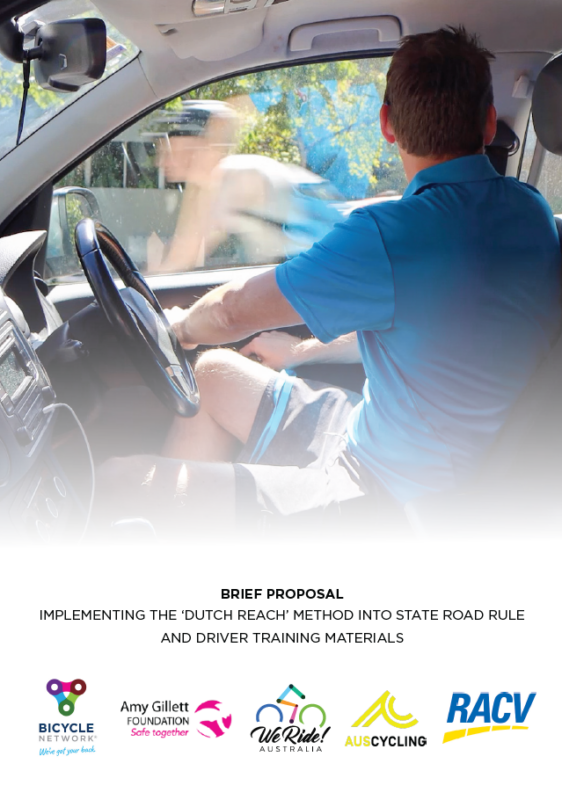The problem
Dooring is a serious risk for bike riders and available prevention measures are rarely deployed.
Dooring is one of the most common crashes for riders and causes serious injury and death.
Bike lanes often overlap the door zone, or the space taken by the open door of a parked vehicle, and the road rule concerning dooring is widely misunderstood and frequently infringed.
Australian Road Rule 269(3), which is consistent across all states and territories, says “A person must not cause a hazard to any person or vehicle by opening a door of a vehicle, leaving a door of a vehicle open, or getting off, or out of, a vehicle.”
This covers opening a vehicle door, leaving a door of a vehicle open, or getting off, or out of, a vehicle. The rule also covers passengers exiting vehicles, stepping out of a bus and riders dismounting a motorcycle.
The serious consequences of dooring is under-appreciated. Police have previously failed to penalise infringements and infringement penalties in most state and territories are too low.
In Victoria between July 2011 and June 2016, according to VicRoads, there were 771 car doorings involving bike riders. Of these two were fatalities and 177 were serious injuries.
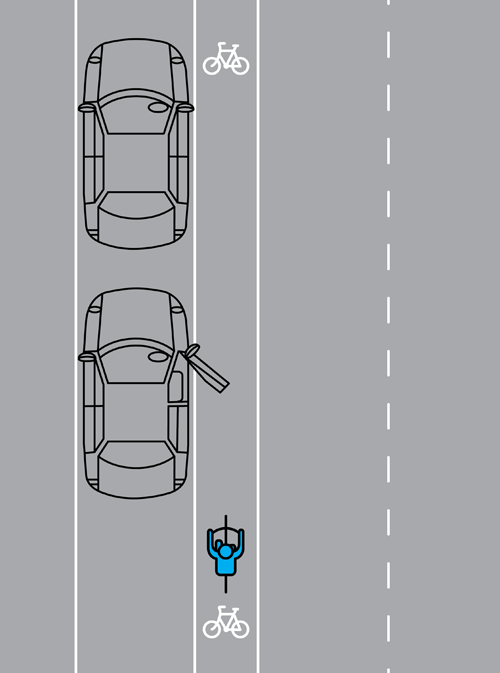
The solution
Bike riders must have space to ride without the risk of being doored. There are three ways we can achieve this.
Infrastructure
As much as possible, roads must be developed in a way that keeps people riding bikes out of the door zone.
The safest and most practical means of doing this is with separated bike lanes, where bike lanes are protected with a physical barrier, such as a kerb or safety bollard.
A bike lane with a painted ‘buffer zone’ between the lane and the parking space may also help protect bike riders.
Education and training
The person opening the vehicle door, dismounting or exiting a vehicle is always legally responsible for avoiding obstructing traffic. It is therefore critical that drivers are properly educated about how to safely exit a vehicle.
Safe driver behaviours, such as the ‘Dutch Reach’ method of exiting a car, should be included in all state road rule handbooks and driver training manuals.
Police need specific training in how to respond to dooring crashes and must consistently penalise infringements.
Technology
Car manufacturers such as Mercedes and Ford are rolling out new models with ‘exit warning’ technology, which is able to alert drivers of an approaching bike.
This is an exciting advance in car technology that could play a pivotal role in protecting vulnerable road users.
Over the long term, this growth of this technology may form the basis of amendments to ANCAP Car Safety Ratings and the Australian Design Rules development program.
Advice for drivers
Victoria’s road authority, VicRoads, advises drivers:
- Get into the habit of always using your mirrors and doing a head check before opening your car door.
- Reach for the door handle with the left (inside) hand, as shown in the diagram to the right. This maneuver, known as the Dutch Reach, will twist your body slightly and make checking easier.
- Open the door a little and look back up the road for bikes and other vehicles.
- If clear get out of the vehicle and cross to the footpath at the rear of the car so you have a view of traffic approaching from behind.
- Don’t be distracted by using your mobile phone.
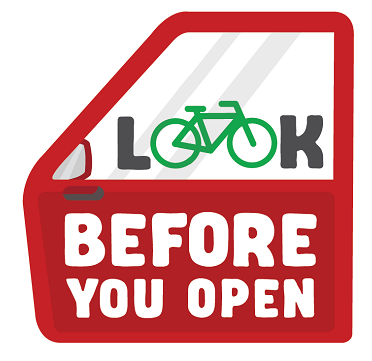
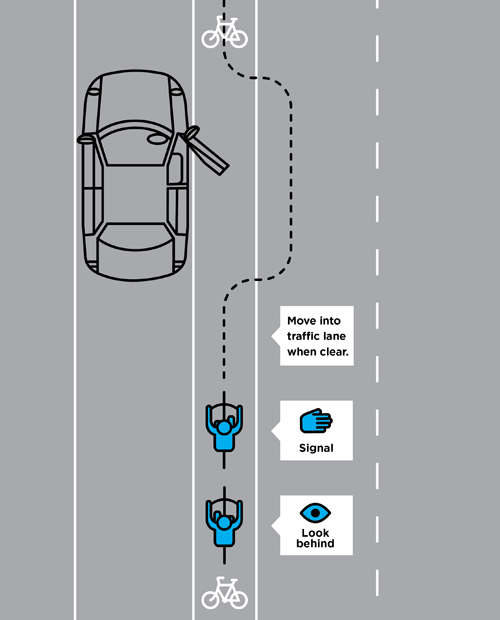
Advice for bike riders
While it is never the rider’s fault when hit by an opening door, bike riders must be aware of the risk and position themselves so that any chance of a collision is reduced.
This means riding outside the door zone, so that your handlebars or the widest part of your bike is one metre away from any parked vehicle. Riding outside the door zone should be your default position.
To pass outside the door zone you will sometimes have to leave the bike lane and merge into the adjacent traffic lane. Scan ahead as far as possible and give yourself plenty of time to do this.
If you swerve into traffic you risk being run over by vehicles beside you. Be sure to check first, then signal before merging into the adjacent lane when it’s clear.
Beware of passengers exiting taxis from a left-side door while stopped in traffic. This is a traffic infringement but it is not uncommon.
Slower speed reduces your stopping time and lessens trauma from a crash, though it cannot prevent dooring.
If you are doored, exchange details with the other party, seek witnesses and report the crash to the police. For advice and assistance with claiming redress, contact Bicycle Network’s Riders Rights service.
Read up on the rules for bike riding in each state and territory of Australia.
Bringing the ‘Dutch Reach’ to Australia
What is a ‘Dutch Reach’?
The “Dutch Reach” method is, quite simply, opening a car door using the hand furthest from the door. In Australia, this means using your left hand to open the driver-side door. This means that drivers are forced to turn their body and take a
precautionary look back over their shoulder for any oncoming traffic, including people on bikes (right).
The method is designed for the safety of all road users, but specifically aims to reduce incidents where car doors open in the path of oncoming bike riders.
A number of countries are already making changes. The United Kingdom has recently revised their Highway Code, recommending that drivers use the Dutch Reach technique when exiting vehicles.
At present, South Australia is only the state to recommend the technique in its state road rules. It is time for the rest of Australia to catch up.
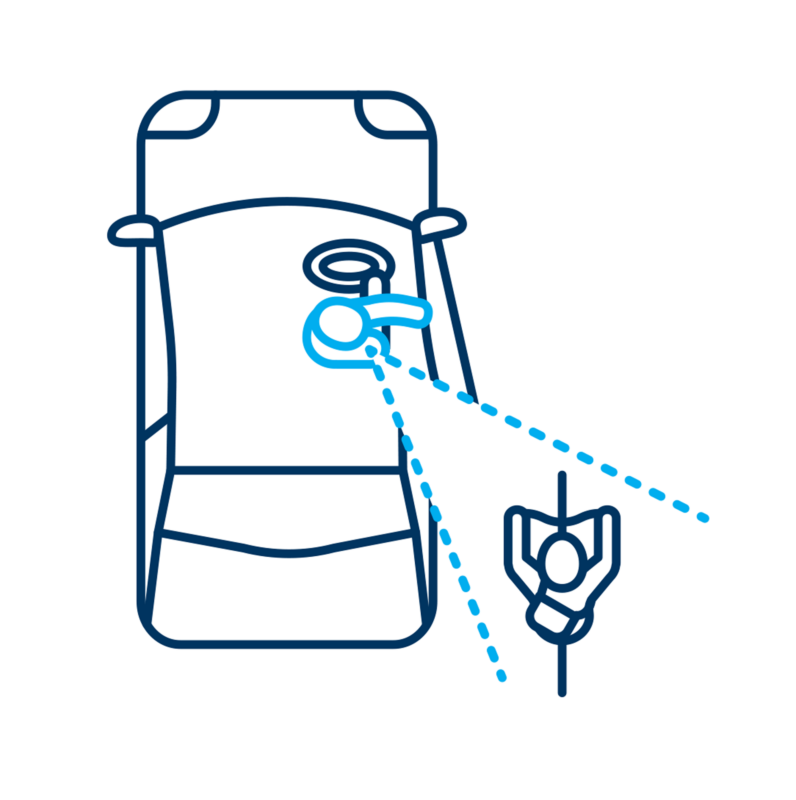
Bicycle Network reaches out
In January 2022, Bicycle Network partnered with Amy Gillet Foundation, We Ride Australia, AusCycling and RACV to make the call for road rule changes in Victoria that will encourage safer driver behaviours when exiting a parked vehicle.
In a joint submission, our organisations proposed that the ‘Dutch Reach’ technique should be included in Victoria’s road rule handbooks and learner driver materials.
The Dutch Reach technique involves a driver using their left hand when they turn to open the driver-side door. The movement forces the person to turn their head and recognise any vulnerable road users, such as bicyclists or motorcyclists, in the adjacent road space.
You can read our joint proposal here.
The long road to recognition
Victoria now has the highest penalties for dooring of any state in Australia but it has been a long road to recognition of the seriousness of dooring. All states and territories must begin to adequately address the issue of dooring.
In April 2010 James Cross was doored and thrown under a truck. Despite that he died of horrific injuries the police did not charge or penalise in any way the driver who doored him.
This terrible road death and the deplorable response from Victoria Police provoked a campaign from Bicycle Network and others, resulting in:
- a Parliamentary Inquiry which more than doubled the minimum penalty for dooring
- an awareness campaign by Bicycle Network and local and state government
- training for Police in dealing with dooring
- studies of the frequency, locations and causes of dooring.
Trace our campaign
Our reporting on dooring in our regular In the Loop enews to Bicycle Network members and friends traces our campaigning over the years.
March 2010. James Cross, 22, of Hawthorn, was ‘doored’ and propelled under the wheels of a five tonne trailer being pulled by a dump truck.
Cross, a Monash University student, died at the scene of chest and pelvic injuries.
11 August 2011. There has been a spike in car door collisions during the past year, according to the latest figures on crashes experienced by Bicycle Network members.
In the 2010-11 year to June 30, there were 43 recoded ‘doorings’ of members, well up from 19 in the previous 12-month period.
Until this sudden doubling, member doorings were in the low twenties each year.
3 May 2012. A new study investigating car doorings in Melbourne has found that the problem is highly concentrated on just a few streets and therefore should be fixable.
Remarkably, thirty per cent of all crashes occurred on just four streets – St Kilda Road, Collins Street, Chapel Street and Elizabeth Street.
The most common ten streets represent 47 per cent of all dooring crashes involving bike riders.
The study, “Bicycle Rider Collisions with Car Doors”, was commissioned by Road Safe Action Group Inner Melbourne (RSAGIM).
Operation Door Knock is a response to the rise in doorings which suddenly spiked in 2009 and 2010.
The operation is a joint venture of Bicycle Network and Road Safe Action Group – Inner Melbourne (RSAG–IM), together with Victoria Police and VicRoads.
30 May 2012.The Parliamentary Committee examining proposed measures to address the problem of bike rider-car door collisions has concluded its hearings.
Some 94 submissions were made and eight of those were invited to appear before the committee and be questioned.
Michael Cross and Nicky Martin, the parents of James Cross, who died in a dooring incident in Hawthorn in 2010, made a powerful presentation to the Parliamentarians. In the James Cross case no charges were ever made against the driver, despite eye-witness accounts available to the police.
There was overwhelming support for a change in the minimum penalty, which is just one penalty unit. And this minimum has become the standard penalty, with police reluctant to push even severe cases into the courts, where higher, but still inadequate, penalties applied.
12 June 2012. A team including members of the Road Safe Action Group Inner Melbourne (RSAGIM) and Bicycle Network took to the streets during the week of 28 May to survey road users about the issue of dooring.
This is an early step in the ongoing behaviour change campaign to combat both the causes and consequences of this problem.
Representatives of the cities of Yarra, Melbourne, Port Phillip and Stonnington (all RSAGIM members) joined with Bicycle Network team members in stopping and interviewing both bike riders and pedestrians at locations in Brunswick Street, Fitzroy, St. Kilda Road, Melbourne and Chapel Street, Prahran with a survey designed to build baseline understanding about awareness of the dooring issue across various sections of the community.
1 August 2012. The state government has more than doubled the fined for doorings following a campaign by riders for action to curtail the rise in such crashes, and the serious injuries and deaths which can result.
The minimum fine has been increased to 2.5 penalty units, or $352. If properly publicised, this new higher fine will lead to greater caution on the behalf of drivers entering and leaving vehicles.
Court imposed penalties have doubled to a maximum of ten penalty units, an increase from $423 to $1,408.
Bicycle Network had called for doubling of both on-the-spot and court penalties in its submission to the Parliamentary Inquiry into dooring in May this year.
15 October 2012. Victoria police have been urged to conduct training for police members regarding enforcement of the offence of car dooring, particularly those deployed in inner Melbourne municipalities with high bike riding activity.
The recommendation appears in the final report of the Inquiry into the “Road Safety Amendment (Car Doors) Bill 2012” – the ‘dooring’ inquiry conducted by the Economy and Infrastructure Legislation Committee of Victoria’s Legislative Council.
The Inquiry, spurred by the tragic death of James Cross in 2010, examined the case for increased penalties and greater enforcement of the relevant laws.
The Committee expressed concern that in the case of Mr James Cross a potential charge of ‘opening a vehicle door to the danger of another’ was not pursued.
The Committee stated that all ‘car dooring’ incidents reported to police should be fully investigated and appropriate action be taken, regardless of whether it results in a collision.
The Committee also supports the view (stated by Victoria Police) that if a collision resulted, at minimum an infringement notice should be issued.
Another major recommendation was that police consider the development of guidelines to assist police members to determine when it is appropriate for a ‘car dooring’ offence to be enforced through the Magistrates’ Court.
“The Committee believes improved enforcement could be best achieved through further training and education of police officers regarding the existing road rule”, the report said.
“The Committee notes that the offence is geographically concentrated, with 91 per cent of ‘car dooring’ injuries occurring within 10 inner city municipalities.
“Targeted education of police who are deployed in these areas may be the most effective way of ensuring all ‘car dooring’ incidents are dealt with appropriately and consistently.”
The committee noted that Road Rule 269(3) is a strict liability offence: Once you open the car door and cause hazard to another the offence is complete.
“The Committee believes that some police members may not be aware that causing a hazard with a car door is sufficient to establish an offence under Road Rule 269(3),” the report said.
“Intent, recklessness, negligence and whether a person looked or did not look prior to opening the car door are irrelevant.
“Evidence provided to the Committee and the Coroner’s report from the Inquest into the death of Mr James Cross indicate Road Rule 269(3) is not being consistently enforced.”
18 December 2014. A driver has been convicted and fined $1200 over a dooring in Highett Road in May where the bike rider died of head injuries in hospital eight days later.
The rider, who had pre-existing health problems, was riding an e-bike down the narrow shopping strip without wearing a helmet.
The court heard that Paul Raymond Faulkner, a labourer of Chelsea Heights who pleaded guilty to the charge, had slowly opened the door of his parked car to about 30 centimetres before the victim hit it and he fell onto the road.
Prosecutor Senior Constable Mike Duthil said Faulkner had parked his car at 12.05pm when the victim struck the partly opened door.
Two witnesses had stated that Faulkner had slowly opened it to about 30 centimetres.
Faulkner, who was charged with opening a door to impede a person after the death, told police he had looked in his mirror and not seen anyone, then opened his door slowly.
“I don’t know where he came from,” he said.
Faulkner’s defence barrister said her client had tested negative to alcohol, had assisted the injured man at the scene and had no prior convictions.
She also submitted that the government needed to implement plans for more bike lanes.
12 March 2015. There has been another death where a rider ricochetted off an open car door and under the wheels of a following truck, this time in Sydney Road, Brunswick.
The tragedy is remarkably similar to the death of student James Cross in Glenferrie Road Hawthorn in April 2010.
Both occurred in busy shopping strips with high parking turnover, a tram corridor and limited bike facilities. Both were struck by a following truck after first colliding with a door opened in their path.
The rider who died in Sydney Road was Melbourne-based Italian chef, Alberto Paulon, 25, who was riding to his workplace in Carlton. He was following his partner who also worked at the same restaurant.
According to reports, the driver claimed to have seen the first bike but not the second.
8 October 2017. The first car is now on the market that will momentarily lock drivers and passengers in a parked car if sensors detect a bike approaching from behind.
Bicycle Network has previously reported on the development of sensors that when fitted to cars can detect to approach of bikes.
Several vehicles have been released that use the sensors to provide audible and/or visual warnings to car occupants.
But this still relied on unreliable humans to heed the warning and keep the door shut until the rider passed.
But now, occupants of the new Audi A8, if they ignore the warning, will be physically restrained by a locked door as the bike, or another vehicle, passes the parked car.
If the sensor detects a bike, the door will be held closed for .8 of a second.
As a bike travelling at 20 kph will cover 4.5 metres in that time, the rider should be passed the door before the passenger or driver is able to swing the door into the riders path.
A joint proposal, co-signed by Bicycle Network, Amy Gillet Foundation, We Ride Australia, AusCycling and RACV, was sent to Victorian ministers and road authorities. The proposal recommends that the ‘Dutch Reach’ technique be included in road rule handbooks and learner driver materials, to better educate drivers on how to safely exit their vehicle.
Take action
Together we can raise awareness of dooring and establish effective prevention.
Share on social
Share our campaign and show your wish for urgent action. #Togetherwecan
Become a member
Become a member today and together we can make it easier for more people to ride.


